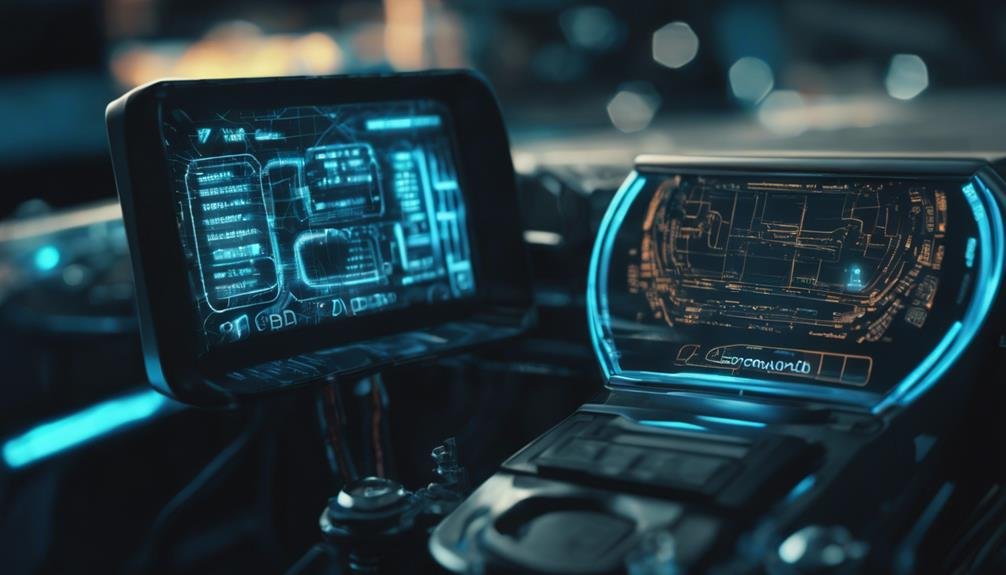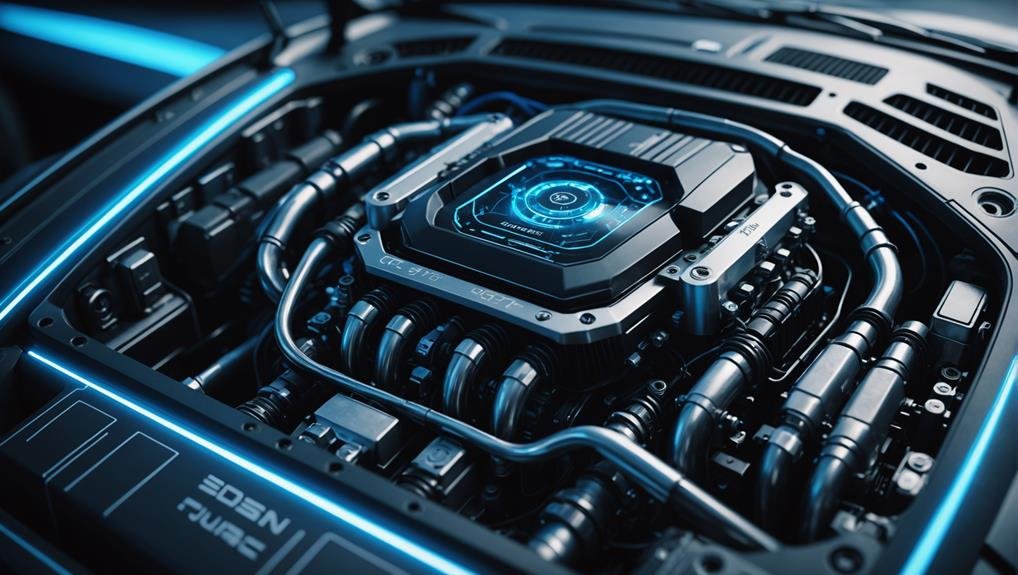When your dashboard's 'check engine' light illuminates, it's often accompanied by an engine code DTC, a unique sequence of letters and numbers that identifies the specific issue affecting your vehicle's performance. DTC codes, or Diagnostic Trouble Codes, pinpoint problems ranging from oxygen sensor issues to catalytic converter malfunctions. These codes, generated by your vehicle's onboard diagnostic system, empower you to manage maintenance and repairs effectively. By understanding DTC codes, you can prioritize repairs, plan maintenance schedules, and allocate resources efficiently. As you investigate this topic further, you'll uncover the intricacies of DTC codes and how they can help you maintain a smooth-running vehicle.
Key Takeaways
- A DTC (Diagnostic Trouble Code) is a unique sequence of letters and numbers indicating a specific vehicle issue, including engine problems.
- Engine fault codes fall under DTC codes, ranging from oxygen sensor issues to catalytic converter malfunctions, and can be identified using vehicle manuals or OBD-II scanners.
- DTC codes consist of unique characters providing information on the type and location of the issue, empowering vehicle owners to manage maintenance and repairs effectively.
- The check engine light often accompanies DTC codes, aiding in efficient problem diagnosis, and understanding these codes is crucial for addressing vehicle problems promptly and ensuring compliance.
- Deciphering an OBD-II DTC involves interpreting standardized codes consisting of five characters, which helps identify the specific problem area and guides repair prioritization.
Understanding DTC Codes
When your vehicle's onboard diagnostic system (OBD) detects a problem, it generates a DTC code to help you identify the issue. This code, also known as a Diagnostic Trouble Code, is a unique sequence of letters and numbers that corresponds to a specific problem in your vehicle's engine or other systems.
As a vehicle owner, understanding DTC codes is essential for prompt action on vehicle issues. Your vehicle manual will often provide a list of common DTC codes and their corresponding meanings, but you can also use on-board diagnostics (OBD-II) scanners to read the codes and diagnose the problem.
Fault codes, such as engine fault codes, are often referred to as DTC codes, and they can be used to identify issues ranging from faulty oxygen sensors to malfunctioning catalytic converters. By understanding DTC codes, you can take control of your vehicle's maintenance and repairs, ensuring that your vehicle runs smoothly and efficiently.
What Is a DTC Code?
You're probably wondering what a DTC code actually is, so let's break it down: a DTC, or Diagnostic Trouble Code, is a vital system generated by a vehicle's onboard diagnostic (OBD) system to indicate specific issues.
When your vehicle's check engine light, also known as the malfunction indicator light, comes on, it's usually accompanied by a DTC code that provides a specific fault index. This code is critical for diagnosing malfunctions in vehicles, helping drivers and technicians pinpoint problems efficiently.
The code consists of a unique combination of characters that provide information on the type and location of the vehicle issue. DTC codes are necessary for maintaining vehicle safety and performance, as they alert users to potential problems that need attention, ensuring compliance with emission regulations.
Vehicle manufacturers use DTC codes to create manufacturer-specific codes, which can be accessed through telematics systems. Understanding DTC codes is key to effectively addressing vehicle issues, ensuring proper maintenance and preventing more significant problems down the line.
Where Do DTCs Come From?

Where Do DTCs Come From?
Your vehicle's onboard diagnostic system generates DTCs in response to a malfunction or anomaly it detects, using a complex network of sensors, computers, and software to identify and report issues. This sophisticated system is designed to alert you to potential problems, enabling you to address engine malfunctions and specific problems before they cause further damage.
Here's how it works:
- Sensors monitor performance: Sensors throughout your vehicle track performance metrics, such as engine speed, fuel injection, and exhaust gas composition.
- Computers analyze data: Onboard computers process the sensor data, comparing it to predetermined parameters to identify anomalies.
- DTCs are generated: When an anomaly is detected, the onboard diagnostic system generates a Diagnostic Trouble Code (DTC) to alert you to the issue.
Reading an OBD-II DTC
Now that your vehicle's onboard diagnostic system has generated a DTC, it's time to decipher the code to identify the problem area.
Reading an OBD-II DTC involves interpreting each character to pinpoint the problem area. You'll notice that OBD-II DTC codes are standardized and consist of five characters.
The initial character of an OBD-II DTC indicates the system type where the issue is detected, giving you a starting point for your diagnosis.
By understanding each character, you'll be able to identify the specific problem area, which is vital for addressing vehicle malfunctions promptly.
Effective vehicle maintenance and troubleshooting rely heavily on accurately reading and interpreting DTC codes. With this knowledge, you'll be able to diagnose and repair issues more efficiently, saving you time and money in the long run.
Interpreting a DTC

How do you break down a DTC code to identify the root cause of the problem? To accurately diagnose a vehicle issue, you need to understand the structure of a DTC code and decode each character. A DTC code consists of a letter and four numbers, with the letter indicating the system affected and the numbers specifying the issue.
Here's how to interpret a DTC code:
- Identify the system affected by the letter (e.g., 'P' for powertrain).
- Recognize the type of fault indicated by the initial number (e.g., '0' for a generic fault).
- Decode the specific issue described by the remaining numbers (e.g., '420' for a catalyst system efficiency below threshold).
Proper interpretation of DTCs is essential for diagnosing vehicle issues correctly and ensuring timely maintenance.
In the case of J1939 DTC codes, you'll also need to take into account the SPN (Suspect Parameter Number), FMI (Failure Mode Identifier), OC (Occurrence Count), and CM (Component Identification). By understanding the structure of a DTC code, you can pinpoint the malfunction accurately and take the necessary steps to repair the vehicle.
Common DTC Codes Explained
You've likely encountered some common DTC codes in your troubleshooting exploration, and understanding what they mean can get you closer to resolving the issue quickly. Diagnostic Trouble Codes (DTCs) are a key tool in diagnosing issues with your vehicle's engine code. Here are some common DTC codes and their meanings:
| DTC Code | Fault | System |
|---|---|---|
| P0420, P0430 | Catalyst system efficiency below threshold | Emission |
| P0171 | System too lean in bank one | Fuel |
| P0300 | Random or multiple cylinder misfires | Ignition |
| P0440 | Evaporative emission control system malfunction | Emission |
These codes can help you identify the specific fault in your vehicle's system, which is important in diagnosing issues quickly and accurately. For instance, a P0171 code indicates a fuel delivery issue, while a P0300 code suggests ignition or fuel system problems. By understanding these codes, you can pinpoint the malfunction and take the necessary steps to repair it. Remember, each DTC code has specific causes related to the identified malfunction, aiding in accurate diagnosis and repair.
Managing DTC Codes for Fleets

Effectively managing DTC codes is crucial for fleet operators, as it enables proactive maintenance, reduces downtime, and improves fleet efficiency as a whole. To achieve this, you'll need access to the OBD-II port to retrieve DTC codes, which can be done using handheld scanners. However, monitoring DTC codes for an entire fleet can be a challenge.
Here are three key strategies to help you effectively manage DTC codes for your fleet:
- Implement telematics systems: These systems provide a centralized platform for monitoring and tracking DTC codes across your fleet, enabling proactive maintenance and reducing downtime.
- Set up alerts: Receive immediate notifications on DTC codes, enabling you to take swift action and minimize downtime.
- Utilize a centralized platform: This allows you to track and monitor DTC codes for your entire fleet, making it easier to identify trends and take proactive measures.
How to Clear a DTC Code
After implementing strategies to manage DTC codes for your fleet, the next step is to know how to clear a DTC code once the underlying issue has been resolved. Clearing a DTC code involves using a diagnostic scanner to erase the stored code from the vehicle's memory. This process doesn't fix the problem, but rather removes the warning indicator until the issue reoccurs. It's crucial to address the root cause of a DTC code before clearing it to prevent potential safety hazards or further damage to the vehicle.
To clear a DTC code, you'll need to:
| Step | Action |
|---|---|
| 1 | Fix the underlying issue that triggered the code |
| 2 | Use a diagnostic scanner to reset the code |
| 3 | Verify the code is cleared and the warning indicator is off |
| 4 | Monitor the vehicle to make sure the problem doesn't reoccur |
DTC Severity and Meaning

Understanding DTC codes requires grasping their severity levels and meanings, which help you prioritize repairs and plan maintenance schedules. This knowledge enables you to allocate resources effectively, ensuring your vehicle receives the necessary attention to prevent breakdowns and costly repairs.
Here are three key aspects of DTC severity levels and meanings:
- Urgency of addressing: DTC severity levels provide guidance on the urgency of addressing the issue, allowing you to prioritize repairs and minimize downtime.
- Specific problem identification: The meaning of DTC codes reveals the specific problem and its potential impact on the vehicle, enabling you to target the root cause of the issue.
- Preventive maintenance: Severity levels assist in planning maintenance schedules, helping you prevent further damage and costly repairs by promptly addressing DTC codes.
Frequently Asked Questions
What Can Cause a DTC Code?
You'll find that a DTC code can be triggered by a range of issues, including faulty oxygen sensors, loose gas caps, engine overheating, fuel system problems, transmission issues, electrical faults, vacuum leaks, or exhaust system failures.
What Does It Mean When DTC Is On?
When the DTC is on, it means your vehicle has detected a problem that needs attention; the check engine light will alert you, and you'll need to address the issue to guarantee safety, efficiency, and compliance with emissions regulations.
How Do You Reset a DTC Code?
You'll need an OBD-II scanner to reset a DTC code; simply connect it to your vehicle, select the "erase code" option, and follow the prompts to clear the code from your system.
How to Look up DTC Code?
You can look up a DTC code by connecting an OBD-II scanner to your vehicle's onboard computer, then using the device to retrieve the code and identify the issue, so you can fix it quickly.
Is It Safe to Clear DTC Codes?
You're wondering if it's safe to clear DTC codes. Generally, it's okay if you've fixed the underlying issue, but clearing codes without resolving the problem can mask ongoing issues, and some codes may reappear if the root cause isn't addressed.
Conclusion
Now that you've explored the world of DTC codes, you're better equipped to diagnose and address issues in your vehicle.
By understanding what DTC codes are, where they originate from, and how to read and interpret them, you'll be able to identify and fix problems more efficiently.
Remember, managing DTC codes is essential for maintaining your vehicle's health and extending its lifespan.
